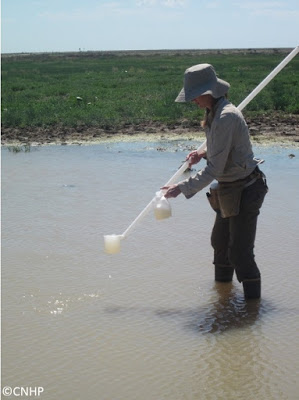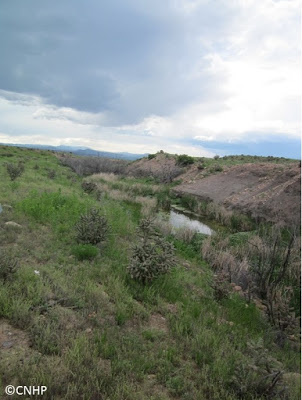By Laurie Gilligan, CNHP Wetland Ecologist
The wetlands team kicked off their water chemistry data collection pilot project in the Lower Arkansas Basin under perfect weather conditions: rain, lightning, mud, and more rain! All of the spring rain has filled playas that have not been saturated in years, and is greening up the Arkansas River floodplain and its marshes. These conditions will give our crew the opportunity to test how well our data collection methods work in waters with high variability in sediment and water levels. However, accessing sites safely has meant dodging the notoriously fierce thunderstorms that roll over the open southeastern plains.
 |
| Joanna Lemly, CNHP wetland ecologist, collects water samples in a playa on the southeastern plains of Colorado. |
 |
| Pools within a small stream outside Florence, Colorado provide good habitat for native plains fish species. |
CNHP is excited to add water chemistry measurements to this year’s wetland assessments. While water chemistry measurements are frequently taken in lakes and rivers, more research is needed on nutrient levels, metal loads, and other water chemistry measurements in shallow vegetated wetlands. By adding water chemistry measurements to our wetland condition assessments, we can begin to observe the relationships between the wetland’s water chemistry and its overall condition. The first step with this pilot year of water quality sampling is to refine protocols and analysis, and to get a glimpse of the range of variation in water chemistry parameters that we may see in the plains.
 |
| Playa on Bureau of Land Management (BLM) land in Huerfano County, Colorado. With extra spring moisture in 2015, many playas in the Lower Arkansas Basin showed concentric rings of vegetation-in this case, an inner ring of spreading yellowcress (Rorripa sinuata). |




